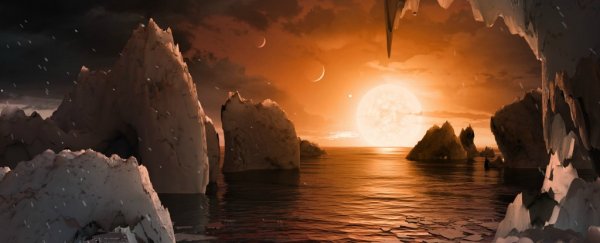Our newly discovered 'sister solar system' - a seven-planet conga line orbiting an ultra-cool dwarf star called TRAPPIST-1 - has been hailed as a potentially habitable pocket of the Universe, flush with liquid water and temperate climates, and only 39 light-years away.
But the closer we look, the less 'alien-friendly' this star system appears, with scientists now finding that TRAPPIST-1 is so volatile, either its three 'Earth-like' planets have one hell of a magnetosphere, or we're looking at yet another set of uninhabitable worlds.
A team led by astronomer Krisztián Vida from Konkoly Observatory in Hungary has been analysing luminosity patterns in the raw photometric data of TRAPPIST-1, obtained during the K2 mission of NASA's Kepler space telescope.
Over an 80-day period, they clocked 42 high-energy flares blasting from TRAPPIST-1, including five that were 'multi-peaked' eruptions, meaning they gave off several bursts of energy in one go.
The strongest eruption the team identified was about as powerful as the largest flare we've ever witnessed from our own Sun - the infamous Carrington Event of 1859, which if it happened today, would devastate global communication systems.
At the time, the flare sent electrical surges through telegraph lines, and gave rise to aurorae so bright, they woke up gold miners in the Rocky Mountains, fooling them into thinking it was morning.
But if life on Earth can withstand flares like the Carrington Event, why can't hypothetical aliens on TRAPPIST-1's three Earth-like planets?
The first thing to consider is that the average time between these flares was just 28 hours, so we're talking serious and near-constant bombardment here.
And the researchers go so far as to say the solar storms caused by TRAPPIST-1 's flares would be hundreds or thousands of times more powerful than the storms that hit Earth.
According to a separate study released last year, it would take 30,000 years for a planet's atmosphere to stablise after one of these powerful flares - so they're not getting much done in just 28 hours.
On top of all of that, the planets in the TRAPPIST-1 star system are much closer to their star than we are to our Sun.
That means this relentless bombardment would likely destroy any stability in their atmospheres, making it very difficult for even the most primitive life to get a foothold.
"The frequent strong flares of TRAPPIST-1 are probably disadvantageous for hosting life on the orbiting exoplanets, as the atmospheres of the exoplanets are constantly altered and cannot return to a steady state," the team concludes.
Just to drive this depressing point home even further, Evan Gough over at Universe Today points out that Earth's robust magnetic field protects us from the worst parts of the Sun's flares, but it's unlikely the TRAPPIST-1 planets have the same shield up.
"This study suggests that planets like those in the TRAPPIST system would need magnetospheres of tens to hundreds of Gauss, whereas Earth's magnetosphere is only about 0.5 Gauss," says Gough.
"How could the TRAPPIST planets produce a magnetosphere powerful enough to protect their atmosphere?"
So things aren't looking so great for our sister solar system.
And while we've pretty much gotten used to the emotional roller coaster that is the search for life elsewhere in the Universe, this is a tough one, because remember that Google Doodle of our new planet friends?

They just look like such a cool hang.
One thing to keep in mind is that the study is still undergoing peer-review, so the results might be subject to change.
But if taken alongside previous studies that have already brought the system's habitability into question, we might have to reconsider those awesome NASA travel posters, and come up with something more… Hellscapey.
The study has been submitted to the Astrophysical Journal for review, but you can read it online now at arXiv.org.
